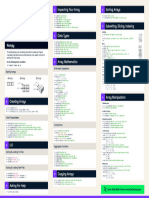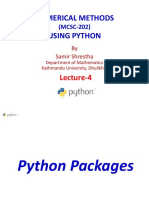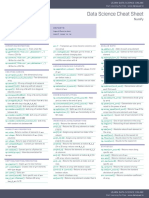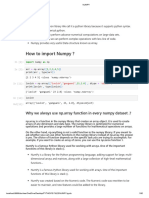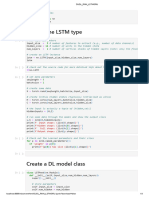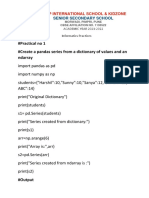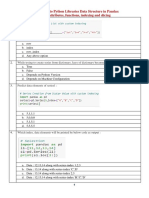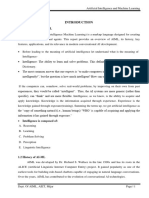session-15-numpy-tricks
November 14, 2024
0.0.1 np.sort
Return a sorted copy of an array.
https://numpy.org/doc/stable/reference/generated/numpy.sort.html
[ ]: # code
import numpy as np
a = np.random.randint(1,100,15)
a
[ ]: array([11, 53, 28, 50, 38, 37, 94, 92, 5, 30, 68, 9, 78, 2, 21])
[ ]: b = np.random.randint(1,100,24).reshape(6,4)
b
[ ]: array([[12, 52, 42, 6],
[29, 18, 47, 55],
[61, 93, 83, 9],
[38, 63, 44, 85],
[ 8, 87, 31, 72],
[40, 71, 2, 7]])
[ ]: np.sort(a)[::-1]
[ ]: array([94, 92, 78, 68, 53, 50, 38, 37, 30, 28, 21, 11, 9, 5, 2])
[ ]: np.sort(b,axis=0)
[ ]: array([[ 8, 18, 2, 6],
[12, 52, 31, 7],
[29, 63, 42, 9],
[38, 71, 44, 55],
[40, 87, 47, 72],
[61, 93, 83, 85]])
0.0.2 np.append
The numpy.append() appends values along the mentioned axis at the end of the array
1
� https://numpy.org/doc/stable/reference/generated/numpy.append.html
[ ]: # code
np.append(a,200)
[ ]: array([ 11, 53, 28, 50, 38, 37, 94, 92, 5, 30, 68, 9, 78,
2, 21, 200])
[ ]: b
[ ]: array([[12, 52, 42, 6],
[29, 18, 47, 55],
[61, 93, 83, 9],
[38, 63, 44, 85],
[ 8, 87, 31, 72],
[40, 71, 2, 7]])
[ ]: np.append(b,np.random.random((b.shape[0],1)),axis=1)
[ ]: array([[12. , 52. , 42. , 6. , 0.22006275],
[29. , 18. , 47. , 55. , 0.81740634],
[61. , 93. , 83. , 9. , 0.89146072],
[38. , 63. , 44. , 85. , 0.84519124],
[ 8. , 87. , 31. , 72. , 0.24007274],
[40. , 71. , 2. , 7. , 0.48056374]])
0.0.3 np.concatenate
numpy.concatenate() function concatenate a sequence of arrays along an existing axis.
https://numpy.org/doc/stable/reference/generated/numpy.concatenate.html
[ ]: # code
c = np.arange(6).reshape(2,3)
d = np.arange(6,12).reshape(2,3)
print(c)
print(d)
[[0 1 2]
[3 4 5]]
[[ 6 7 8]
[ 9 10 11]]
[ ]: np.concatenate((c,d),axis=0)
[ ]: array([[ 0, 1, 2],
[ 3, 4, 5],
2
� [ 6, 7, 8],
[ 9, 10, 11]])
[ ]: np.concatenate((c,d),axis=1)
[ ]: array([[ 0, 1, 2, 6, 7, 8],
[ 3, 4, 5, 9, 10, 11]])
0.0.4 np.unique
With the help of np.unique() method, we can get the unique values from an array given as parameter
in np.unique() method.
https://numpy.org/doc/stable/reference/generated/numpy.unique.html/
[ ]: # code
e = np.array([1,1,2,2,3,3,4,4,5,5,6,6])
[ ]: np.unique(e)
[ ]: array([1, 2, 3, 4, 5, 6])
0.0.5 np.expand_dims
With the help of Numpy.expand_dims() method, we can get the expanded dimensions of an array
https://numpy.org/doc/stable/reference/generated/numpy.expand_dims.html
[ ]: # code
a.shape
[ ]: (15,)
[ ]: np.expand_dims(a,axis=0).shape
[ ]: (1, 15)
[ ]: np.expand_dims(a,axis=1)
[ ]: array([[11],
[53],
[28],
[50],
[38],
[37],
[94],
[92],
[ 5],
3
� [30],
[68],
[ 9],
[78],
[ 2],
[21]])
0.0.6 np.where
The numpy.where() function returns the indices of elements in an input array where the given
condition is satisfied.
https://numpy.org/doc/stable/reference/generated/numpy.where.html
[ ]: a
[ ]: array([11, 53, 28, 50, 38, 37, 94, 92, 5, 30, 68, 9, 78, 2, 21])
[ ]: # find all indices with value greater than 50
np.where(a>50)
[ ]: (array([ 1, 6, 7, 10, 12]),)
[ ]: # replace all values > 50 with 0
np.where(a>50,0,a)
[ ]: array([11, 0, 28, 50, 38, 37, 0, 0, 5, 30, 0, 9, 0, 2, 21])
[ ]: np.where(a%2 == 0,0,a)
[ ]: array([11, 53, 0, 0, 0, 37, 0, 0, 5, 0, 0, 9, 0, 0, 21])
0.0.7 np.argmax
The numpy.argmax() function returns indices of the max element of the array in a particular axis.
https://numpy.org/doc/stable/reference/generated/numpy.argmax.html
[ ]: # code
a
[ ]: array([11, 53, 28, 50, 38, 37, 94, 92, 5, 30, 68, 9, 78, 2, 21])
[ ]: np.argmax(a)
[ ]: 6
[ ]: b
4
�[ ]: array([[12, 52, 42, 6],
[29, 18, 47, 55],
[61, 93, 83, 9],
[38, 63, 44, 85],
[ 8, 87, 31, 72],
[40, 71, 2, 7]])
[ ]: np.argmax(b,axis=0)
[ ]: array([2, 2, 2, 3])
[ ]: np.argmax(b,axis=1)
[ ]: array([1, 3, 1, 3, 1, 1])
[ ]: # np.argmin
np.argmin(a)
[ ]: 13
0.0.8 np.cumsum
numpy.cumsum() function is used when we want to compute the cumulative sum of array elements
over a given axis.
https://numpy.org/doc/stable/reference/generated/numpy.cumsum.html
[ ]: a
[ ]: array([11, 53, 28, 50, 38, 37, 94, 92, 5, 30, 68, 9, 78, 2, 21])
[ ]: np.cumsum(a)
[ ]: array([ 11, 64, 92, 142, 180, 217, 311, 403, 408, 438, 506, 515, 593,
595, 616])
[ ]: b
[ ]: array([[12, 52, 42, 6],
[29, 18, 47, 55],
[61, 93, 83, 9],
[38, 63, 44, 85],
[ 8, 87, 31, 72],
[40, 71, 2, 7]])
[ ]: np.cumsum(b,axis=1)
5
�[ ]: array([[ 12, 64, 106, 112],
[ 29, 47, 94, 149],
[ 61, 154, 237, 246],
[ 38, 101, 145, 230],
[ 8, 95, 126, 198],
[ 40, 111, 113, 120]])
[ ]: np.cumsum(b)
[ ]: array([ 12, 64, 106, 112, 141, 159, 206, 261, 322, 415, 498,
507, 545, 608, 652, 737, 745, 832, 863, 935, 975, 1046,
1048, 1055])
[ ]: # np.cumprod
np.cumprod(a)
[ ]: array([ 11, 583, 16324,
816200, 31015600, 1147577200,
107872256800, 9924247625600, 49621238128000,
1488637143840000, 101227325781120000, 911045932030080000,
-2725393596491966464, -5450787192983932928, -3786066610405281792])
[ ]: a
[ ]: array([11, 53, 28, 50, 38, 37, 94, 92, 5, 30, 68, 9, 78, 2, 21])
0.0.9 np.percentile
numpy.percentile()function used to compute the nth percentile of the given data (array elements)
along the specified axis.
https://numpy.org/doc/stable/reference/generated/numpy.percentile.html
[ ]: a
[ ]: array([11, 53, 28, 50, 38, 37, 94, 92, 5, 30, 68, 9, 78, 2, 21])
[ ]: np.percentile(a,50)
[ ]: 37.0
[ ]: np.median(a)
[ ]: 37.0
6
� 0.0.10 np.histogram
Numpy has a built-in numpy.histogram() function which represents the frequency of data distribu-
tion in the graphical form.
https://numpy.org/doc/stable/reference/generated/numpy.histogram.html
[ ]: # code
a
[ ]: array([11, 53, 28, 50, 38, 37, 94, 92, 5, 30, 68, 9, 78, 2, 21])
[ ]: np.histogram(a,bins=[0,50,100])
[ ]: (array([9, 6]), array([ 0, 50, 100]))
0.0.11 np.corrcoef
Return Pearson product-moment correlation coefficients.
https://numpy.org/doc/stable/reference/generated/numpy.corrcoef.html
[ ]: salary = np.array([20000,40000,25000,35000,60000])
experience = np.array([1,3,2,4,2])
np.corrcoef(salary,experience)
[ ]: array([[1. , 0.25344572],
[0.25344572, 1. ]])
0.0.12 np.isin
With the help of numpy.isin() method, we can see that one array having values are checked in a
different numpy array having different elements with different sizes.
https://numpy.org/doc/stable/reference/generated/numpy.isin.html
[ ]: # code
a
[ ]: array([11, 53, 28, 50, 38, 37, 94, 92, 5, 30, 68, 9, 78, 2, 21])
[ ]: items = [10,20,30,40,50,60,70,80,90,100]
a[np.isin(a,items)]
[ ]: array([50, 30])
7
� 0.0.13 np.flip
The numpy.flip() function reverses the order of array elements along the specified axis, preserving
the shape of the array.
https://numpy.org/doc/stable/reference/generated/numpy.flip.html
[ ]: # code
a
[ ]: array([11, 53, 28, 50, 38, 37, 94, 92, 5, 30, 68, 9, 78, 2, 21])
[ ]: np.flip(a)
[ ]: array([21, 2, 78, 9, 68, 30, 5, 92, 94, 37, 38, 50, 28, 53, 11])
[ ]: b
[ ]: array([[12, 52, 42, 6],
[29, 18, 47, 55],
[61, 93, 83, 9],
[38, 63, 44, 85],
[ 8, 87, 31, 72],
[40, 71, 2, 7]])
[ ]: np.flip(b,axis=1)
[ ]: array([[ 6, 42, 52, 12],
[55, 47, 18, 29],
[ 9, 83, 93, 61],
[85, 44, 63, 38],
[72, 31, 87, 8],
[ 7, 2, 71, 40]])
0.0.14 np.put
The numpy.put() function replaces specific elements of an array with given values of p_array. Array
indexed works on flattened array.
https://numpy.org/doc/stable/reference/generated/numpy.put.html
[ ]: # code
a
[ ]: array([110, 530, 28, 50, 38, 37, 94, 92, 5, 30, 68, 9, 78,
2, 21])
[ ]: np.put(a,[0,1],[110,530])
8
� 0.0.15 np.delete
The numpy.delete() function returns a new array with the deletion of sub-arrays along with the
mentioned axis.
https://numpy.org/doc/stable/reference/generated/numpy.delete.html
[ ]: # code
a
[ ]: array([110, 530, 28, 50, 38, 37, 94, 92, 5, 30, 68, 9, 78,
2, 21])
[ ]: np.delete(a,[0,2,4])
[ ]: array([530, 50, 37, 94, 92, 5, 30, 68, 9, 78, 2, 21])
0.0.16 Set functions
• np.union1d
• np.intersect1d
• np.setdiff1d
• np.setxor1d
• np.in1d
[ ]: m = np.array([1,2,3,4,5])
n = np.array([3,4,5,6,7])
np.union1d(m,n)
[ ]: array([1, 2, 3, 4, 5, 6, 7])
[ ]: np.intersect1d(m,n)
[ ]: array([3, 4, 5])
[ ]: np.setdiff1d(n,m)
[ ]: array([6, 7])
[ ]: np.setxor1d(m,n)
[ ]: array([1, 2, 6, 7])
[ ]: m[np.in1d(m,1)]
[ ]: array([1])
9
� 0.0.17 np.clip
numpy.clip() function is used to Clip (limit) the values in an array.
https://numpy.org/doc/stable/reference/generated/numpy.clip.html
[ ]: # code
a
[ ]: array([110, 530, 28, 50, 38, 37, 94, 92, 5, 30, 68, 9, 78,
2, 21])
[ ]: np.clip(a,a_min=25,a_max=75)
[ ]: array([75, 75, 28, 50, 38, 37, 75, 75, 25, 30, 68, 25, 75, 25, 25])
[ ]: # 17. np.swapaxes
[ ]: # 18. np.uniform
[ ]: # 19. np.count_nonzero
[ ]: # 21. np.tile
# https://www.kaggle.com/code/abhayparashar31/
↪best-numpy-functions-for-data-science-50?scriptVersionId=98816580
[ ]: # 22. np.repeat
# https://towardsdatascience.com/10-numpy-functions-you-should-know-1dc4863764c5
[ ]: # 25. np.allclose and equals
[ ]:
10






